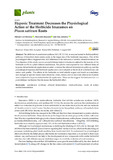Hypoxic treatment decreases the physiological action of the herbicide imazamox on pisum sativum roots
Fecha
2020Versión
Acceso abierto / Sarbide irekia
Tipo
Artículo / Artikulua
Versión
Versión publicada / Argitaratu den bertsioa
Identificador del proyecto
ES/1PE/AGL2016-77531-R
Impacto
|
|
10.3390/plants9080981
Resumen
The inhibition of acetolactate synthase (ALS; EC 2.2.1.6), an enzyme located in the biosynthetic pathway of branched-chain amino acids, is the target site of the herbicide imazamox. One of the physiological effects triggered after ALS inhibition is the induction of aerobic ethanol fermentation. The objective of this study was to unravel if fermentation induction is related to the toxicity of the ...
[++]
The inhibition of acetolactate synthase (ALS; EC 2.2.1.6), an enzyme located in the biosynthetic pathway of branched-chain amino acids, is the target site of the herbicide imazamox. One of the physiological effects triggered after ALS inhibition is the induction of aerobic ethanol fermentation. The objective of this study was to unravel if fermentation induction is related to the toxicity of the herbicide or if it is a plant defense mechanism. Pea plants were exposed to two different times of hypoxia before herbicide application in order to induce the ethanol fermentation pathway, and the physiological response after herbicide application was evaluated at the level of carbohydrates and amino acid profile. The effects of the herbicide on total soluble sugars and starch accumulation, and changes in specific amino acids (branched-chain, amide, and acidic) were attenuated if plants were subjected to hypoxia before herbicide application. These results suggest that fermentation is a plant defense mechanism that decreases the herbicidal effect. [--]
Materias
Acetolactate synthase,
Ethanol fermentation,
Imidazolinones,
Mode of action,
Aerobic fermentation
Editor
MDPI
Publicado en
Plants, 2020, 9(8): 981
Departamento
Universidad Pública de Navarra/Nafarroako Unibertsitate Publikoa. Institute for Multidisciplinary Research in Applied Biology - IMAB
Versión del editor
Entidades Financiadoras
This work was funded by the Spanish Ministry of Economy and Competitiveness (AGL2016-77531-R).






